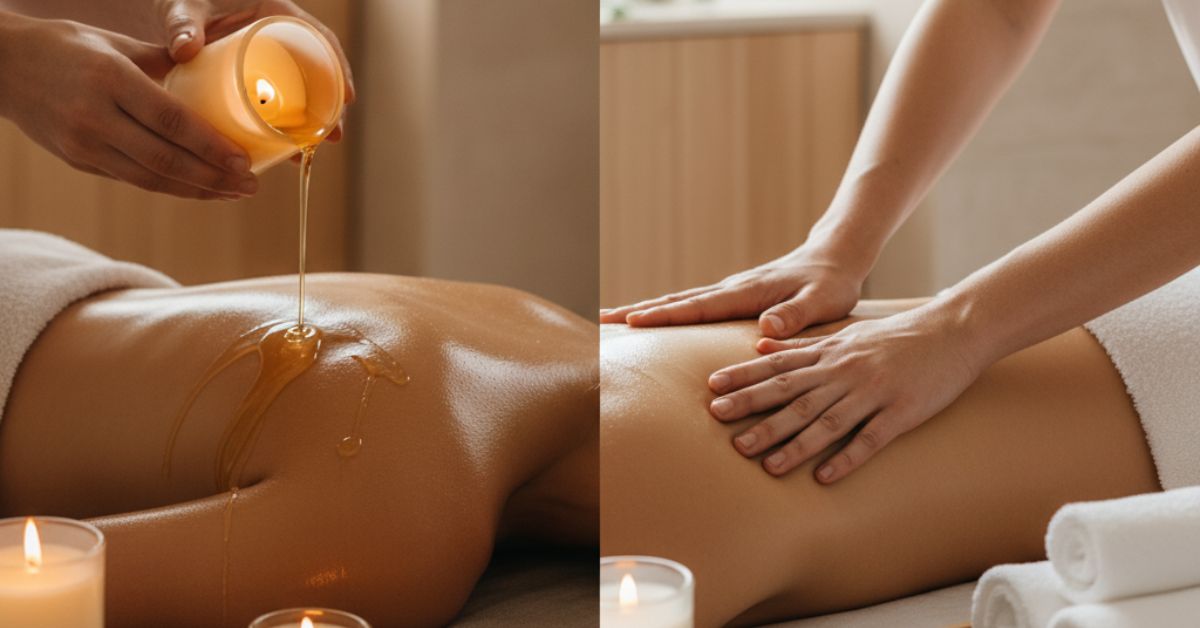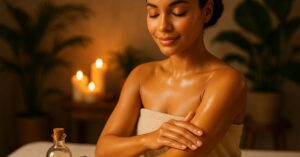
Intro — quick answer up front
If you’re wondering whether a candle massage or a traditional massage “feels better”, the honest answer is: it depends. They feel different — not necessarily better or worse — and the right choice depends on what you want: deep therapeutic pressure, sensual relaxation, heating and moisturising skin, aromatherapy, or something more intimate and sensual.
This long-form guide walks through the science, sensations, benefits, safety, product guidance (massage oils and candles), recommended settings, and how to choose between a candle massage and classic modalities like Swedish or deep-tissue. By the end you’ll know which one is likely to suit your body, mood and lifestyle.
What is a candle massage?
A candle massage uses a specially formulated massage oil candle — a candle that melts into warm, skin-safe oil instead of hot wax. The candle is lit, allowed to melt a little, then the warm oil is poured or applied directly to the skin and used as massage medium.
Key points:
- Candle wax for massage is formulated from skin-safe oils and butters (e.g., soy, coconut, jojoba, shea) with a low melting point so it becomes a warm oil rather than hot wax.
- It combines heat therapy, moisturising oil, and aromatherapy.
- Often used in spas and by couples at home as a sensual/relaxing treatment.
What is a traditional massage?
Traditional massage refers to established modalities like Swedish, deep tissue, sports massage, and remedial/manual therapies. These use a dedicated massage oil or lotion applied at room temperature (or slightly warmed in hands) and rely on hands-on techniques — effleurage, petrissage, friction, compression, tapotement, etc.
Key points:
- Therapeutic intent varies: relaxation (Swedish), tension release (deep tissue), performance recovery (sports).
- Oils used are typically neutral carrier oils (sweet almond, grapeseed, fractionated coconut) or specialist blends.
- Pressure, technique, and therapist training determine effectiveness.
Sensation comparison: how they feel on the skin and muscles
Candle massage: warm, enveloping, sensual
- Immediate warmth: The oil is warm, providing instant soothing heat to tight muscles and improving local circulation.
- Silkiness: The oil often contains butters and emollients, resulting in a gliding, luxurious feel that can be richer than standard massage oil.
- Aromatics: Scented candles add a strong aromatherapy element, affecting mood and perception of relaxation.
- Sensory depth: Many people find the combination of heat, scent, and touch deeply relaxing or intimate.
Traditional massage: controlled, targeted, versatile
- Temperature-neutral: Standard oils are usually at or near room temperature; warmth comes from therapist’s hands rather than the oil.
- Friction & pressure: Better for delivering high-friction strokes and deeper targeting (e.g., trigger points) without the slipperiness of heavy candle oils.
- Precision: Therapists can use varied pressures and techniques for muscular correction, alignment, or rehabilitation.
Benefits — a direct comparison
Benefits of candle massage
- Warmth and relaxation: Heat relaxes muscles and can reduce stiffness.
- Skin hydration: Richer oils and butters deeply moisturise — great for dry seasons (Australian winters).
- Enhances intimacy and mood: Often used in couples treatments or by spas offering sensory rituals.
- Aromatherapy: Powerful mood influence; can enhance relaxation, sleep, or sensuality depending on essential oils used.
- Ritual feel: The act of lighting a candle can contribute to mental transition from busy to calm.
Benefits of traditional massage
- Therapeutic outcomes: Proven for reducing muscle tension, improving mobility, and aiding recovery.
- Customisable pressure: From light to very deep pressure targeting specific musculoskeletal issues.
- Clinical application: Often integrated into physiotherapy, sports recovery, and chronic pain management.
- Broad training availability in Australia: Many registered therapists trained in remedial and sports modalities.
When candle massage might feel better (use cases)
- You want relaxation and sensory indulgence (e.g., after a stressful week).
- You love warm oils and highly moisturised skin — great for dry Australian climates or the cooler months.
- You’re booking a couples or romantic treatment.
- You prefer gentler, flowing strokes with emphasis on comfort over clinical pressure.
- You want aromatherapy to play a major role in the session.
When traditional massage might feel better
- You have specific muscle pain, tension knots, or recovery needs.
- You need deep tissue work or focused therapeutic techniques.
- You’re an athlete seeking performance or recovery benefits.
- You need a clinical or remedial approach overseen by trained practitioners.
Safety first — what need to know about candle massage
Candle massages are safe when done with purpose-built massage candles and practitioners who understand temperature and product formulation. However, there are important cautions:
- Never use ordinary paraffin candles on skin. Standard wax candles can cause severe burns.
- Check melt temperature. Good massage candles are formulated to melt at skin-safe temperatures (often < 55°C), but temperature should always be tested on the inside wrist first.
- Patch test: Anyone with sensitive skin or allergies should patch test the oil on a small area before full application.
- Avoid open wounds, sunburn or inflamed skin.
- Pregnancy: Many essential oils are contraindicated during pregnancy — pregnant clients should consult their midwife or GP and request pregnancy-safe blends. Many therapists offer pregnancy-safe massage options without heat or certain oils.
- Children and elderly: Extra caution — skin can be thinner and more sensitive. Use lower temperatures.
- Asthma and fragrance sensitivities: Strong aromas can trigger respiratory symptoms for some people.
- Professional training: Therapists should be trained in temperature control and product handling.
Essential Australian note: If you are receiving a treatment at a clinic or spa, confirm the therapist is registered with a relevant Australian professional association (e.g., Massage & Myotherapy Australia, Massage Association Australia, or state registries) and that the product is labelled for skin use.
Ingredients — what’s inside massage oils and candles
Understanding what’s in a product helps you choose one that suits your skin, climate and preferences.
Common carrier oils
- Sweet almond oil: light, nourishing, good glide.
- Grapeseed oil: light, non-greasy, suitable for oily skin.
- Fractionated coconut oil (MCT): long shelf life, non-greasy.
- Jojoba: actually a liquid wax, closest to skin sebum.
- Apricot kernel: gentle, good for sensitive skin.
Butters & emulsifiers in candles
- Shea butter: rich, deeply moisturising — great in dry Australian winters.
- Cocoa butter: emollient with distinct scent; heavier.
- Candelilla/soy wax: plant-based waxes used to form a candle that melts into oil.
- Emulsifiers: needed so melted wax becomes pourable oil and not greasy solid.
Essential oils & fragrances
- Lavender:
- Eucalyptus: invigorating, commonly used in Australia (but can be strong).
- Ylang-ylang, jasmine: sensual notes.
- Citrus: uplifting, but phototoxic oils (e.g., bergamot) should be avoided before sun exposure.
Additives to avoid / watch for
- Synthetic phthalates or cheap fragrance chemicals if you’re sensitive.
- Paraffin/petroleum-based waxes for direct skin contact.
- Allergens such as nut oils for people with severe allergies — always check labels.
Practical session differences — what to expect in a treatment
Candle massage session (typical)
- Therapist discusses preferences, allergies, and tests temperature.
- Candle lit and allowed to melt into a reservoir of warm oil.
- Therapist pours a small amount and begins with gentle strokes, combining warming and slow effleurage.
- Session usually emphasises relaxation; pressure tends to be light-to-moderate.
- Therapist may focus on full-body flow rather than heavy deep tissue work.
- Aftercare: skin may feel moisturised; therapist may towel any excess oil.
Time: 60–90 minutes is common. Some spas offer 30-minute express versions.
Traditional massage session (typical)
- Intake form, therapist identifies problem areas.
- Oil warmed in hands or in a warmer (no open flame on skin).
- Therapist uses targeted techniques — can be light to intense.
- More focus on addressing musculoskeletal issues, trigger points.
- Aftercare: advice on stretches or follow-up sessions.
Time: 30–90 minutes, depending on intent (therapeutic vs relaxation).
Australian-specific considerations
- Climate impact: In Australia, coastal humidity vs inland dryness matters. Heavier candle oils can feel luxurious in dry southern winters (e.g., Melbourne, Hobart) but may feel heavy in hot, humid summers in Darwin or northern Queensland. Choose lighter formulations for summer.
- Sun exposure & essential oils: Avoid phototoxic oils (certain citrus oils) if you plan to sunbathe post-treatment — relevant in Australia’s sunny climate.
- Local scents: Eucalyptus, lemon myrtle, and native Australian botanicals are popular in local blends — they evoke local ambience and can be marketed for Australian audiences.
- Regulatory labeling: When buying products, check for TGA (Therapeutic Goods Administration) implications only if the product makes medicinal claims. Most massage oils and candles should be cosmetic/skin care labelled with ingredient lists under Australian Consumer Law.
- Seasonal promos: Candle massages are often promoted as winter specials in Australia due to their warming nature.
Efficacy: what the research says (summary)
Rigorous clinical trials specifically comparing candle massage vs traditional massage are limited. However:
- Heat + massage: Heat combined with massage can enhance muscle relaxation and pain relief compared to massage alone in many contexts.
- Aromatherapy: Evidence supports that certain essential oils (e.g., lavender) can improve subjective relaxation and sleep quality, though results vary.
- Moisturising skin: Topical emollients clearly improve skin hydration; candle oils with rich butters will hydrate better than light carrier oils.
- Therapeutic pressure: For structural musculoskeletal change, targeted pressure (as in deep tissue or remedial massage) is more effective than general warming techniques.
Bottom line: Candle massage may amplify relaxation and tactile pleasure, but if you need clinical muscular therapy, traditional methods performed by trained therapists have stronger evidence for targeted outcomes.
How to pick the right product — massage oils and candles
When shopping for massage oils and candles in Australia, look for:
- Skin-safe formulation: specifically labelled as “massage candle” or “massage oil” and intended for skin use.
- Ingredient transparency: full INCI list (International Nomenclature of Cosmetic Ingredients).
- Low melt point: product page or label should state safe skin temperature or “low melting point”.
- Natural carrier oils: prefer recognizable carriers (jojoba, almond, grapeseed) if you avoid synthetics.
- No paraffin: avoid paraffin/petroleum for direct skin contact.
- Allergen warnings: nut oils, gluten-containing botanicals, or specific essential oil sensitivities should be declared.
- Australian sellers & standards: choose reputable Australian makers or established international brands with clear shipping/return policies.
- Cruelty-free and vegan options: many Australian buyers look for ethically made products.
- Aroma intensity: stronger fragrances may be overpowering in small treatment rooms — test first.
How to perform a safe candle massage at home (step-by-step)
Note: Use only candles designed for massage.
- Prepare the space: clean, warm room, towels, and a tray for the candle. Dim lights, ventilation if fragrance is strong.
- Check ingredients for allergies. Don’t use nut-based products if you have severe nut allergy.
- Trim the wick (if applicable) to avoid large flame and soot.
- Test temperature: after candle has melted for a few minutes, pour a tiny bit on the inside of your wrist. It should feel warm, not hot.
- Start small: apply a small amount, warm it between hands, then spread with long, gentle strokes.
- Adjust pressure: oil is slippery — for deeper work, use more friction or apply compressions rather than trying to press deeply with sliding strokes.
- Avoid face and genital mucosa unless the product is explicitly labeled as safe for those areas.
- Extinguish candle safely and rest when finished. Blot excess oil with a towel.
- Storage: cool, dark place; avoid direct sun and keep lids on to preserve scents.
Massage techniques adapted for candle oil
Because candle oil is more emollient and slippery, therapists often use:
- Long slow effleurage to maximise warmth and relaxation.
- Palmar compressions or knuckles for pressure rather than deep, single-point friction.
- Circular warming strokes to increase local blood flow.
- Light stretching and joint mobilisations adapted for lubricated skin.
Cost and accessibility — what Australians pay and where to find treatments
(General guidance — prices vary across cities and luxury vs local therapists.)
- Spa candle massage: often priced at a premium compared to standard spa massages because of special product use and sensory framing. Expect to pay more for signature candle rituals at high-end spas.
- Mobile therapists & couples packages: may offer candle options for home visits; check therapist insurance and registration.
- DIY at home: buying a quality massage oil candle is cost-effective long term vs repeated spa visits.
Pros and cons — quick checklist
Candle massage — Pros
- Deeply relaxing, sensual atmosphere
- Warmth soothes muscles and increases touch comfort
- Skin hydration and aroma therapy benefits
- Ideal for pampering and couple experiences
Candle massage — Cons
- Not ideal for deep structural work
- Risk of burns if not using the proper product or an untrained person
- Strong scents might irritate some people
- Can be messy — oil on sheets/clothes
Traditional massage — Pros
- Targeted therapeutic effects for pain and mobility
- Customizable pressures and techniques
- Widely available and evidence-backed for many conditions
Traditional massage — Cons
- Less “spa theatre” and sensory ritual
- May feel too clinical for someone seeking pure relaxation or sensuality
Who should choose which? Practical guides
Choose candle massage if you:
- Want a luxurious, warming, sensory ritual.
- Enjoy aromatherapy and moisturised skin.
- Are seeking relaxation or a romantic experience.
- Don’t need deep structural muscle therapy.
Choose traditional massage if you:
- Have specific muscle pain or sports-related needs.
- Need trigger point release, fascial work, or rehabilitative therapy.
- Prefer evidence-backed clinical outcomes.
Integrating both: hybrid approaches
You don’t have to choose! Many spas and therapists use a hybrid approach:
- Start with warm candle oil for relaxation and to heat tissue.
- Switch to targeted traditional techniques (using a lighter carrier oil or less slippery product) for deeper work.
- Finish with candle oil for closure and skin hydration.
This offers the best of both worlds — sensory warmth and targeted therapy.
DIY vs Professional — when to stay home and when to see a pro
Home: Great for personal pampering, couple rituals, and skin hydration. Use a high-quality massage candle and follow safety steps.
Professional: If you have chronic pain, injuries, or need deep therapeutic work — seek a trained therapist with relevant registration/insurance.
Final verdict — which feels better?
- If your priority is deep muscular change, improved mobility or sports recovery: traditional massage will feel better and be more effective.
- If your priority is relaxation, skin nourishment, sensuality or a warming sensory ritual: candle massage will likely feel better.
Many Australians — depending on season, mood and need — will enjoy both. The best approach is pragmatic: choose candle massage for ritual, relaxation and hydration; choose traditional massage for therapeutic restoration. When in doubt, seek a therapist who offers both and can blend techniques safely.
Frequently Asked Questions
Q: Can I combine candle massage with deep tissue?
A: Yes — many practitioners start with warm candle oil to relax tissue and then switch to targeted techniques with a lighter oil or reduced slip for better friction. Ensure the therapist is trained to transition safely.
Q: Are massage candles eco-friendly?
A: Many are — look for soy, coconut or plant waxes and ethically sourced essential oils. Avoid paraffin and synthetic fragrances if sustainability matters.
Q: How long does a massage oil candle last?
A: It depends on size and frequency of use. A 120–200g candle used for therapy may last multiple sessions; always follow manufacturer guidance.
Q: What about nut allergies?
A: Check labels carefully. If someone has a severe nut allergy, avoid nut-carrier oils and opt for hypoallergenic formulations like jojoba or fractionated coconut (but confirm with allergist if uncertain).
Q: Can I use candle oil on my face?
A: Only if the product specifies face-safe use. Faces are sensitive and have different oil needs; many candle oils are formulated for body use only.






